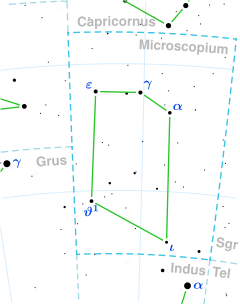
| |
| Observation data Epoch J2000.0 Equinox J2000.0 (ICRS) | |
|---|---|
| Constellation | Sagittarius |
| Right ascension | 20 22 27.50366 |
| Declination | −42° 02′ 58.3648″ |
| Apparent magnitude (V) | +5.58 |
| Characteristics | |
| Spectral type | A0 V |
| U−B color index | −0.008 |
| B−V color index | +0.004 |
| Astrometry | |
| Radial velocity (Rv) | −11.6 km/s |
| Proper motion (μ) | RA: +41.312 mas/yr Dec.: −83.742 mas/yr |
| Parallax (π) | 14.6086 ± 0.1738 mas |
| Distance | 223 ± 3 ly (68.5 ± 0.8 pc) |
| Absolute magnitude (MV) | 1.47 |
| Details | |
| Mass | 2.23±0.02 M☉ |
| Radius | 1.7 R☉ |
| Luminosity | 27.5 L☉ |
| Surface gravity (log g) | 4.33 cgs |
| Temperature | 9,962±339 K |
| Rotational velocity (v sin i) | 79 km/s |
| Age | 161 Myr |
| Other designations | |
| κ Sgr, CD−42°14836, HD 193571, HIP 100469, HR 7779, SAO 230177, WDS J20225-4203 | |
| Database references | |
| SIMBAD | data |
Kappa Sagittarii (κ Sagittarii) is a solitary, white-hued star in the zodiac constellation of Sagittarius. It has an apparent visual magnitude of +5.58, which is bright enough to be faintly visible to the naked eye. According to the Bortle scale, it can be viewed from dark suburban skies. Based upon an annual parallax shift of 15.12 mas as seen from Earth, this star is located around 223 light years from the Sun. It is advancing in the general direction of the Sun with a radial velocity of −11.6 km/s.
This is an A-type main sequence star with a stellar classification of A0 V. It displays an infrared excess, with the measured radiation indicating the star is orbited by a two-component debris disk. The star is about 161 million years old with 2.23 times the mass of the Sun and 1.7 times the Sun's radius. It is radiating 27.5 times the Sun's luminosity from its photosphere at an effective temperature of roughly 9,962 K.
There are two visual companions: component B is a magnitude 12.6 star at an angular separation of 39.3 arc seconds along a position angle of 312°, as of 2000; component C is magnitude 11.6 with a separation of 56.8 arc seconds along a position angle of 283°, as of 1999. Neither star is physically associated with Kappa Sagittarii.
References
- ^ van Leeuwen, F. (2007), "Validation of the new Hipparcos reduction", Astronomy and Astrophysics, 474 (2): 653–664, arXiv:0708.1752, Bibcode:2007A&A...474..653V, doi:10.1051/0004-6361:20078357, S2CID 18759600.
- ^ Cousins, A. W. J. (1983), "UBV photometry of E region standard stars of intermediate brightness", South African Astronomical Observatory Circular, 7 (7): 36–46, Bibcode:1983SAAOC...7...36C.
- ^ Royer, F.; et al. (February 2007), "Rotational velocities of A-type stars. III. Velocity distributions", Astronomy and Astrophysics, 463 (2): 671–682, arXiv:astro-ph/0610785, Bibcode:2007A&A...463..671R, doi:10.1051/0004-6361:20065224, S2CID 18475298.
- ^ Evans, D. S. (June 20–24, 1966), "The Revision of the General Catalogue of Radial Velocities", in Batten, Alan Henry; Heard, John Frederick (eds.), Determination of Radial Velocities and their Applications, Proceedings of IAU Symposium no. 30, vol. 30, University of Toronto: International Astronomical Union, p. 57, Bibcode:1967IAUS...30...57E
- ^ Brown, A. G. A.; et al. (Gaia collaboration) (August 2018). "Gaia Data Release 2: Summary of the contents and survey properties". Astronomy & Astrophysics. 616. A1. arXiv:1804.09365. Bibcode:2018A&A...616A...1G. doi:10.1051/0004-6361/201833051. Gaia DR2 record for this source at VizieR.
- Ammler-von Eiff, Matthias; Reiners, Ansgar (June 2012), "New measurements of rotation and differential rotation in A-F stars: are there two populations of differentially rotating stars?", Astronomy & Astrophysics, 542: A116, arXiv:1204.2459, Bibcode:2012A&A...542A.116A, doi:10.1051/0004-6361/201118724, S2CID 53666672.
- ^ Zorec, J.; Royer, F. (January 2012), "Rotational velocities of A-type stars. IV. Evolution of rotational velocities", Astronomy & Astrophysics, 537: A120, arXiv:1201.2052, Bibcode:2012A&A...537A.120Z, doi:10.1051/0004-6361/201117691, S2CID 55586789.
- ^ Patel, Rahul I.; et al. (February 2017), "The Faintest WISE Debris Disks: Enhanced Methods for Detection and Verification", The Astronomical Journal, 153 (2): 19, arXiv:1612.04818, Bibcode:2017AJ....153...54P, doi:10.3847/1538-3881/153/2/54, S2CID 3006490, 54.
- ^ David, Trevor J.; Hillenbrand, Lynne A. (2015), "The Ages of Early-Type Stars: Strömgren Photometric Methods Calibrated, Validated, Tested, and Applied to Hosts and Prospective Hosts of Directly Imaged Exoplanets", The Astrophysical Journal, 804 (2): 146, arXiv:1501.03154, Bibcode:2015ApJ...804..146D, doi:10.1088/0004-637X/804/2/146, S2CID 33401607.
- "kappa01 Sgr". SIMBAD. Centre de données astronomiques de Strasbourg. Retrieved 2017-07-07.
- ^ Eggleton, P. P.; Tokovinin, A. A. (September 2008), "A catalogue of multiplicity among bright stellar systems", Monthly Notices of the Royal Astronomical Society, 389 (2): 869–879, arXiv:0806.2878, Bibcode:2008MNRAS.389..869E, doi:10.1111/j.1365-2966.2008.13596.x, S2CID 14878976.
- Mason, B. D.; et al. (2014), "The Washington Visual Double Star Catalog", The Astronomical Journal, 122 (6): 3466–3471, Bibcode:2001AJ....122.3466M, doi:10.1086/323920, retrieved 2015-07-22.